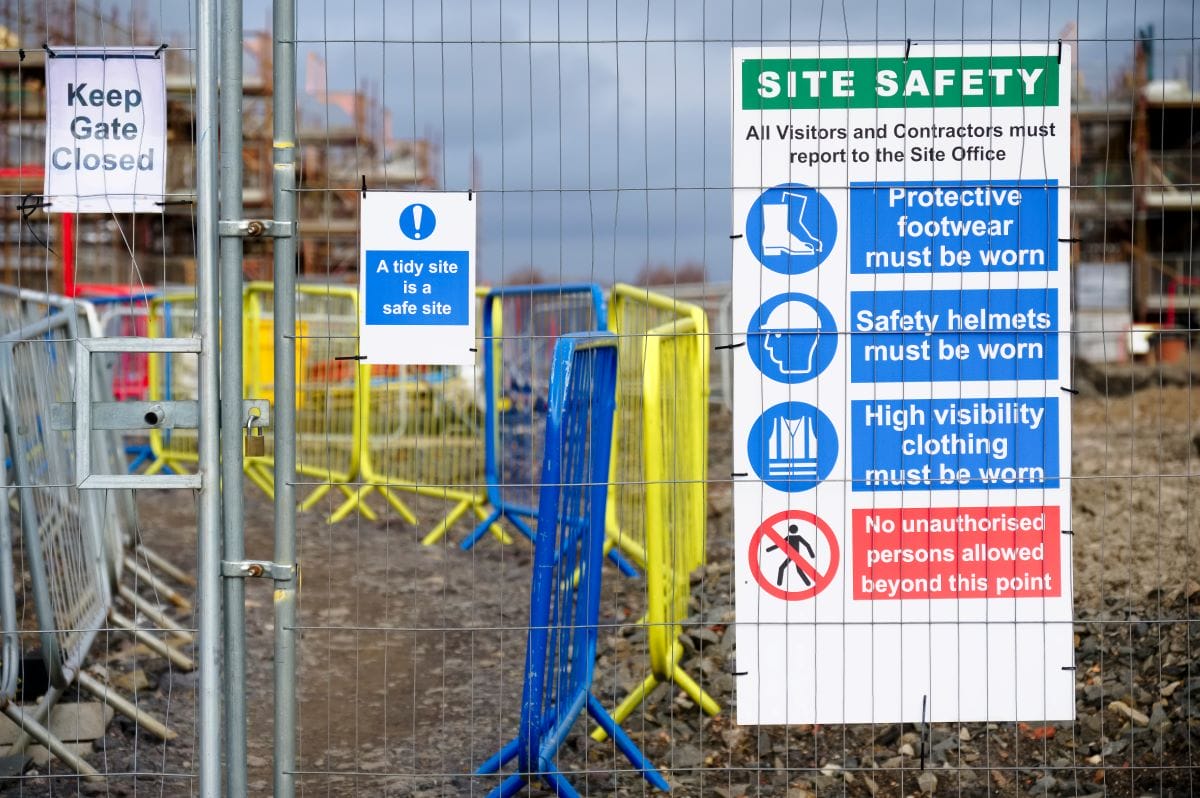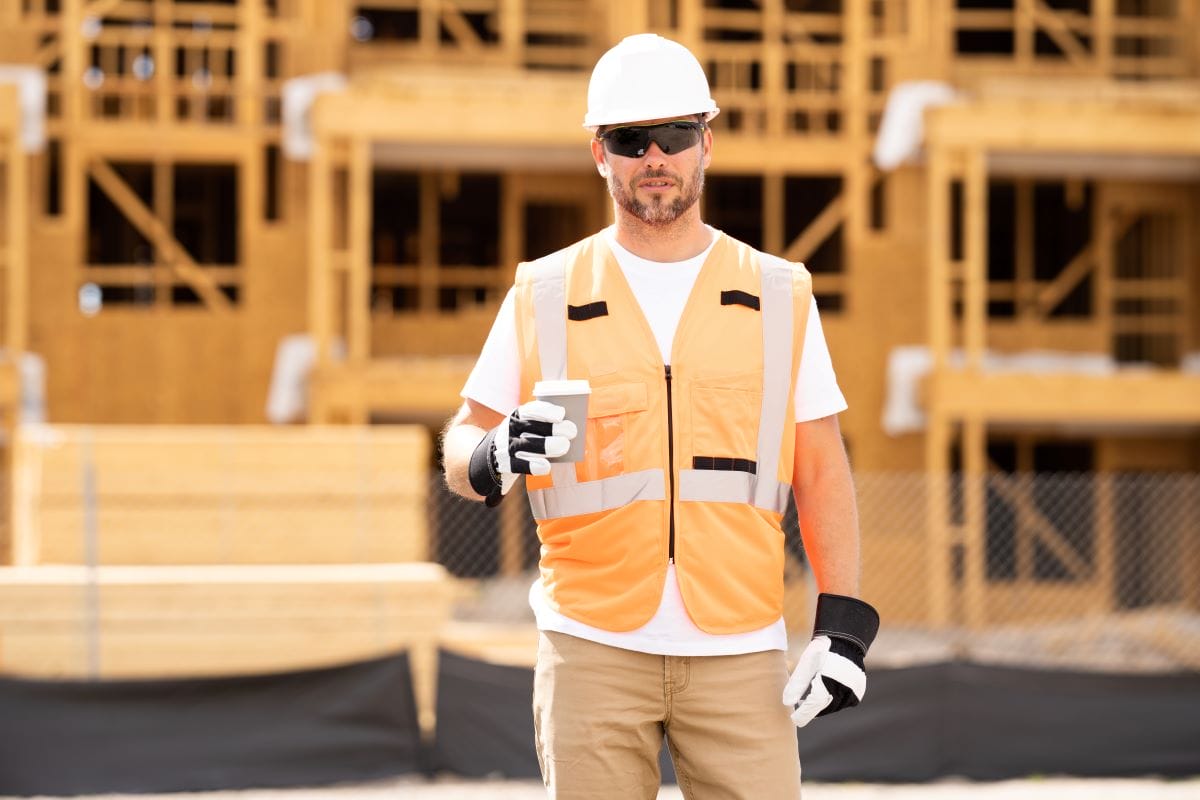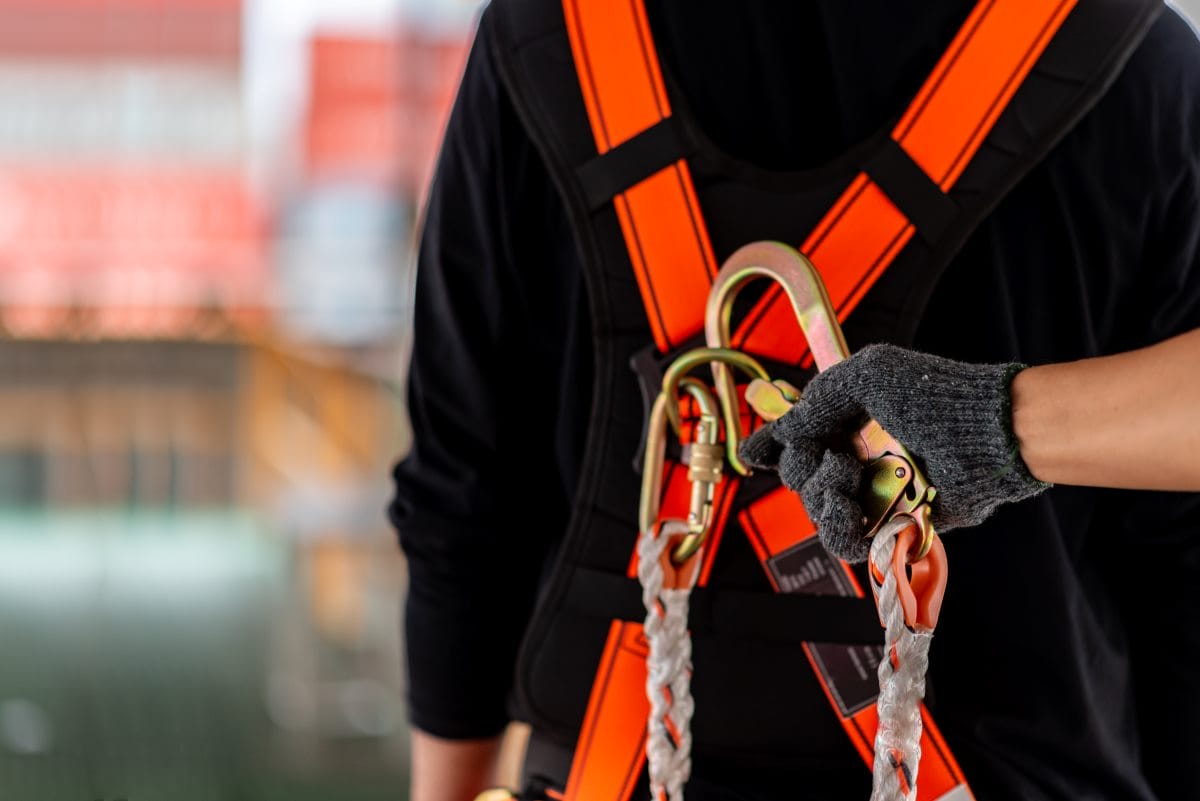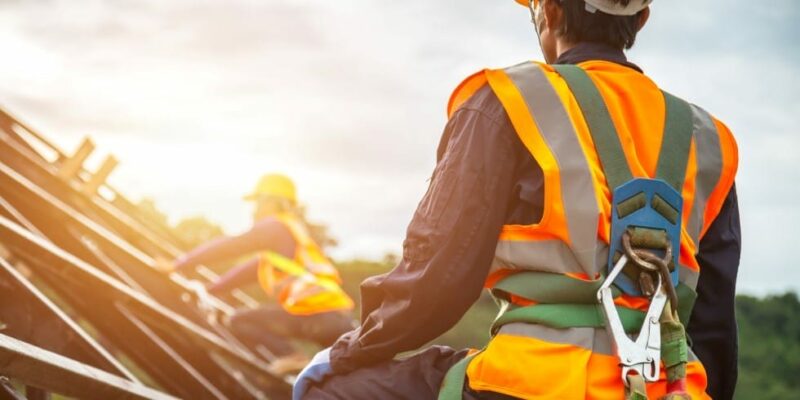When it comes to construction, safety is paramount. ‘Construction safe’ means more than just following rules; it’s about building a culture of continuous awareness and prevention. In this guide, we’ll cover essential strategies to achieve safety excellence on your job site—spanning from leadership roles to tech utilization and regulatory compliance—so you can protect your team and your project without compromise.
Key Takeaways
- Building a culture of safety led by committed leadership and engaging workers in safety procedures is key to preventing accidents and improving productivity on construction sites.
- Regular safety audits, the implementation of safety management systems, and the integration of technology like mobile apps and AI are critical strategies for maintaining construction site safety and managing risks.
- Falls are the leading cause of worker fatalities on construction sites. Adherence to OSHA regulations, including the provision of appropriate personal protective equipment and safety training, is fundamental to construction safety, with severe penalties for violations.
Establishing a Culture of Safety in the Construction Industry

Prioritizing safety above all else is the foundation of a secure construction site. A safety-first mindset within construction companies, steered by committed leaders, is fundamental to creating a secure work environment and reducing accidents. Engaging construction workers in safety practices enhances productivity and efficiency, while also improving employee morale.
A strong safety culture enhances trust between workers and management. It also paves the way for reduced costs related to accidents and a valued company reputation.
Leadership’s Role
Leadership has a significant influence on construction safety. Leaders in construction firms play a pivotal role in setting the tone for a culture of safety, ensuring that everyone is involved in safer operations. Open channels of communication are vital to promote a culture of safety, allowing workers to report hazards or safety concerns without fear of reprisal.
Regular safety meetings and feedback sessions facilitated by leaders enhance the exchange of safety-related information between management and workers. Consistently enforcing safety procedures is another crucial aspect of leadership’s role in safety.
Worker Involvement and Empowerment
Keeping a work environment safe is greatly aided by the engagement and empowerment of workers. Worker empowerment in safety decisions ensures active involvement in workplace safety programs. Encouraging employees who contribute to safety can incentivize all workers to prioritize safety plans.
Providing clarity on the day’s tasks can reduce accidents by minimizing unexpected situations. Fostering a culture of safety also involves helping workers understand the consequences of poor safety. Safety stand-downs offer direct employer-to-employee engagement on safety topics, helping prevent accidents.
Continuous Safety Education
Continuous safety education plays a key part in maintaining a safe work environment. Keeping workers informed about new practices, regulatory changes, and emerging workplace hazards reduces accidents and boosts productivity. Comprehensive safety training prepares employees to safely perform tasks, effectively control hazards, and confidently respond to emergencies, leading to increased morale and enhanced productivity.
Regular updates reflecting industry trends, best practices, and technological advances in the field are essential for effective safety training. Regular safety training sessions, such as biannually or quarterly, ensure workers are consistently equipped with current safety information. Safety promotion requires comprehensive training and education across all levels of the organization.
Key Strategies to Maintain Construction Site Safety

Several key strategies are involved in the complex, multifaceted process of maintaining construction site safety. A robust safety culture within construction firms can lead to a reduction in the number of safety hazards and incidents, improving the company’s safety record and positively influencing financial outcomes. Emphasizing construction safety helps to avoid financial costs associated with incidents while protecting the company’s reputation.
Engineering controls, including barriers, fences, and safety mechanisms, are essential for physically isolating workers from exposure to hazardous zones on construction sites. Furthermore, fire safety and emergency response are pivotal aspects of site safety management.
Implementation of Safety Management Systems
Safety and health programs document how to proactively identify and manage construction site hazards, with guidelines provided by OSHA to help small and medium-sized construction businesses implement these practices effectively. Recording and managing safety incidents through software aids in identifying the root causes of accidents and implementing corrective measures to prevent future incidents.
A proactive construction safety management system effectively prevents accidents through systematic hazard identification and risk management on the job site. Risk assessment is integral to construction safety, involving identifying hazards, analyzing and evaluating associated risks, and implementing controls to manage those risks.
Regular Safety Audits and Inspections
Identifying potential hazards before they cause harm is made possible by regular safety audits and inspections on construction sites. The benefits of routine safety inspections include the reduced risk of accidents, improved worker safety, and lower costs associated with construction site accidents.
Safety inspections on construction sites should be conducted at least once per day. However, the frequency may vary depending on:
- The site’s size
- The number of workers
- The type of work being done
- The hazards present
Utilization of Technology for Safety
Technology’s role in construction safety represents a significant advancement in safety management. Robust communication systems are essential on construction sites to ensure that workers and relevant third parties can be reached immediately in case of emergencies or to communicate hazards. Mobile inspection apps equipped with checklists specifically tailored for construction safety help managers track and verify adherence to safety protocols.
Digitalization of safety processes leads to:
- Increased safety compliance
- Boosted productivity across the team
- Smart systems managing complex high-risk work, such as ensuring those performing tasks like critical lifting, confined space or energized electrical work have the proper approval and qualifications.
Essential Safety Rules Every Construction Worker Should Follow
Given the complex environment of a construction site with many potential hazards, each worker must follow specific safety rules. Personal protective equipment, including goggles, helmets, gloves, ear protection, boots, and high-visibility clothing, is mandatory for all workers and visitors on the construction site. Understanding and following the different types of safety signs is essential for onsite safety.
Reporting any observed defects or near misses as soon as possible is critical in preventing accidents and further issues. Sites must be kept tidy by:
- Removing debris
- Dust
- Loose nails
- Stagnant water
Reporting construction site safety defects helps to eliminate hazards that may cause slips, trips, and falls. Proper organization and secure storage of tools and equipment are necessary to prevent injuries and damage from tools left around. Each task must be performed with the correct equipment to prevent accidents that can occur when tools are misused.
Personal Protective Equipment: The First Line of Defense

In the realm of construction safety, personal protective equipment (PPE) has a significant role. Providing PPE to construction workers is crucial as it can prevent accidents and significantly reduce the severity of injuries. OSHA mandates that employers must provide PPE at no cost to employees, ensuring strict adherence to safety standards.
Common types of PPE on construction sites include:
- Hard hats
- Steel-toe boots
- Reflective safety vests
- Gloves
- Goggles
- High-visibility clothing
Each serves a specific purpose to protect various parts of a worker’s body. PPE acts as the first line of defense against workplace injuries, playing a key role in a construction firm’s commitment to onsite safety excellence.
Head Protection Essentials
Personal protective equipment greatly emphasizes the importance of head protection. Hard hats protect workers from head injuries due to impact, falling or flying objects, electrical shock hazards, and contact with fixed objects. Properly fitted hard hats must be penetration-resistant, shock-absorbent, water and fire-resistant, and include instructions for correct adjustment and replacement of components.
Hard hats are classified into different types and classes, providing varying levels of impact and electrical protection. Hard hats should not be altered or have accessories added that are not approved by the manufacturer, as this can compromise their protective qualities.
Eye and Ear Safety Measures
Personal protective equipment places considerable importance on eye and ear safety measures. Safety glasses must be impact-resistant to protect against flying debris and particles that can cause eye injuries. Wrap-around safety glasses provide the most comprehensive coverage, protecting eyes from the side as well as the front. Anti-fog lenses are crucial in environments with high humidity or temperature changes to maintain clear vision. Safety goggles offer a higher level of protection than safety glasses, with a secure fit that keeps out dust, liquids, and other harmful substances. It’s important for safety eyewear to fit snugly without obstructing vision, and workers should be trained on how to select and wear protective eyewear properly.
Hearing protection is essential on construction sites to:
- Prevent permanent or temporary hearing loss due to exposure to high levels of noise
- Enhance communication
- Reduce workplace accidents
- Improve job quality.
Fall Protection Gear

In the construction industry, personal protective equipment includes the critical component of fall protection gear. Fall protection systems such as guardrails, safety nets, and personal fall arrest systems are vital in preventing worker falls on construction sites. Personal fall arrest systems, required for risk of falls of 6 feet or more, must include an anchor point, a full-body harness, and a connector, such as a lanyard or self-retracting lifeline. A safety harness should support a person’s total weight up to 310 lbs and be part of a fall protection system designed to limit fall impact forces to 1,800 lbs or less.
Different types of lanyards connect the safety harness to the anchor, varying in type and length depending on the task and environment. Here are the different types of lanyards used in fall protection systems:
- Fall arrest lanyards: These lanyards are designed to arrest a fall and are used in situations where there is a risk of falling.
- Positioning lanyards: These lanyards allow workers to use both hands for tasks by leaning back in their harness. They are commonly used on ladders and are not designed to arrest a fall.
- Suspension lanyards: These lanyards support a worker in a lowered position to facilitate hands-free work, such as window washing and painting. However, they must be complemented by a fall arrest system for safety.
Anchors for fall arrest systems must support either 5,000 lbs of force or twice the potential load of a falling person, and need to be engineered and installed by qualified persons. It is important to ensure that the appropriate lanyard is used for each specific task to ensure worker safety.
Scaffolding should have guardrails, mid-rails, toeboards, be on solid footing, and undergo daily inspections by competent persons to ensure its safety. Ladders must be used correctly with three points of contact, tied off securely, and regularly inspected for compliance with OSHA regulations to prevent slips and falls. OSHA mandates that construction employers provide appropriate fall protection gear for employees working at heights of six feet or more above a lower level.
Preventing Common Hazards on Construction Sites
Construction site safety is largely dependent on effectively addressing common hazards on construction sites. In 2021, fall hazards accounted for 46.2% of all fatal falls, slips, and trips in the construction industry, emphasizing the critical need for effective fall protection strategies.
The four most common hazards in construction are:
- Falls
- Struck-by hazards
- Electrical hazards
- Caught-in/between hazards
Falls are the leading cause of worker fatalities. OSHA mandates that employers adhere to the use of personal fall arrest systems above 4 feet for general industry, 5 feet for maritime, and 6 feet for construction.
Employers should consider electrical safety hazards and adhere to standards to prevent electric shock, electrocution, fires, and explosions, highlighting the critical importance of electrical safety issues.
Tasks in confined spaces, such as manholes, crawl spaces, and tanks, pose physical and atmospheric hazards, requiring strict adherence to OSHA’s confined space standards to ensure worker safety.
Trenching and excavation are highly hazardous construction activities that must comply with OSHA standards to protect workers from accidents and injuries inherent to these operations.
Employers must comply with specific OSHA standards for high-risk activities like:
- welding
- cutting
- brazing
- the use of cranes and derricks
Measures are in place to prevent accidents and injuries related to these tasks. With more than 13 job-related deaths occurring each day in the U.S., and one out of five in the construction industry, safety systems addressing various occupational hazards are crucial for worker protection.
Construction sites inherently present dangers like uneven surfaces, fall risks, heavy machinery, and outdoor weather conditions, requiring an array of practices for improving construction site safety and mitigating such risks.
Controlling Exposure to Hazardous Substances
Preventing common hazards on construction sites involves controlling exposure to hazardous substances. Hazardous substances in construction may come in various forms such as:
- Solids
- Liquids
- Vapors
- Gases
- Micro-organisms
All of these pose different risks to workers when handled improperly. Workers can be exposed to hazardous substances through routes such as inhalation, skin contact, or ingestion, typically from eating or smoking with contaminated hands. Exposure to hazardous substances can lead to immediate health effects, like headaches from solvents, or chronic conditions, including occupational cancers and lung diseases.
Given that construction is a high-risk industry for health issues related to hazardous substances, controlling exposure is particularly crucial in this field. Employers are required to implement a written hazard communication program, ensuring all chemical containers on the construction site are clearly labeled and that workers receive thorough training on the handling of chemicals and how to deal with spills. To safely store hazardous chemicals at construction sites, it is essential to:
- Choose well-ventilated, spacious, and above-ground locations
- Label all hazardous substances appropriately according to the manufacturer’s instructions
- Place visible warnings in the storage areas to prevent accidental exposure
- Provide Safety Data Sheets, or links to the SDS Database where they are stored
Adherence to OSHA’s regulatory standards is key in protecting construction workers from the severe health effects of lung cancer or silicosis due to exposure to hazardous substances.
Machinery and Power Tools
Common hazards on construction sites can be effectively prevented through the proper use and maintenance of machinery and power tools. Hand and power tools used on construction sites must meet specific Occupational Safety and Health Administration (OSHA) standards to prevent injuries associated with their misuse. Tools must be inspected prior to use to ensure they are in good repair, and any damaged or defective tools must be removed from service. Sharpness of cutting tools is crucial for safety, and tools like hammers and wrenches should have securely fastened handles and be the correct size without damage.
Power tool operators must be properly trained, use tools according to manufacturer’s recommendations, and turn off and secure equipment when not in use.
Health Programs and Services for Construction Workers
The well-being of construction workers is significantly supported by health programs and services. Some key initiatives include:
- The Substance Abuse and Mental Health Services Administration (SAMHSA) provides support through a National Helpline for individuals facing substance use disorders.
- Creating a stigma-free culture regarding mental health in construction companies allows employees to feel comfortable seeking treatment.
- Employers should ensure Employee Assistance Programs (EAPs) are available for construction workers’ well-being.
Onsite injury prevention services give construction workers access to medical professionals directly at work sites for immediate health and safety support. Some key points to note about these services are:
- They provide immediate support for workers in case of injuries or accidents.
- They help in preventing injuries by identifying potential hazards and implementing safety plans.
- They offer training and education on safety practices and procedures.
- They ensure compliance with OSHA regulations and standards.
In addition, it is important to note that OSHA sets a permissible exposure limit for noise at 90 dBA for an 8-hour workday, above which noise reduction equipment like earplugs or earmuffs is necessary. Exposure to ototoxic chemicals in conjunction with noise increases the risk of hearing loss for construction workers.
Construction sites with motor vehicle operations or work in highway zones must adhere to OSHA requirements to ensure the safety of both workers and non-workers.
Innovations in Construction Safety

As the construction industry continues to evolve, so do the safety measures it implements. Innovations in construction safety, such as wearable technologies and artificial intelligence, are breaking new ground in the quest for safer worksites. Wearable technologies such as smart hard hats, smartwatches, smart glasses, and smart boots are increasingly integrated with sensors and health monitoring systems to enhance job site communication, analyze worker behavior, detect potential hazards, and alert workers to emergencies.
Artificial Intelligence (AI) is used to assess workspaces for ergonomic risk factors and analyze historical safety data to predict potential safety issues, thereby informing proactive measures to reduce the risk of injuries. Emerging technologies such as drones for site surveying, smart lockout/tag-out systems, augmented and virtual reality for training, and prefabrication methods improve safety by reducing workers’ exposure to hazards and enhancing efficiency. Encouraging innovation is vital for enhancing safety in construction, as the development of new safety practices and tools is key to better protecting workers.
Risk Engineering and Assessment Techniques
In the planning and programming stages of construction projects, risk engineering, and assessment techniques are indispensable tools. Risk analysis contributes significantly to the decision-making process in construction. Construction risk engineering uses both qualitative and quantitative methods, with qualitative involving subjectivity and quantitative relying on statistical methods that affect the quality of results.
Different risk analysis techniques, from simple qualitative methods to complex statistical ones, each have specific pros, cons, and application areas in risk management. Choosing a risk assessment method requires considering the ease of result interpretation and reliability of the model to ensure its utility in managing risks.
Some common risk assessment techniques used in construction projects include:
- SWOT analysis
- Delphi technique
- Fault tree analysis
- Event tree analysis
- Monte Carlo simulation
- Sensitivity analysis
By utilizing these techniques, construction professionals can effectively identify, analyze, and manage risks throughout the project lifecycle.
Risk management processes in construction encompass identification, assessment, and the formulation of strategies to handle risks using decision-making models. Assessment techniques involve multi-aspect approaches to project selection and optimizing variants of construction projects through thorough risk identification. Site conditions and project-specific requirements must inform the site-specific risk assessments to ensure tailored safety measures.
Protecting Non-Worker Safety Around Construction Zones
In addition to construction safety largely focused on worker protection, the safety of non-workers near construction zones must also be considered. These individuals may face hazards from improperly designed barricades, vehicle rollovers, and electrical hazards. Road construction sites are protected by signs and barricades, and traffic is redirected to safeguard non-workers. Clear signage indicating pedestrian diversions is essential to protect pedestrians around construction sites. Pedestrians should identify the site entrance and be more vigilant of concentrated vehicle traffic to navigate safely around construction zones. Traffic Marshalls assist and guide pedestrians safely around construction sites.
Construction sites with motor vehicle operations or work in highway zones must adhere to OSHA requirements to ensure the safety of both workers and non-workers.
Adherence to OSHA Regulations and Standards
Following the regulations and standards of the Occupational Safety and Health Administration (OSHA) is a fundamental part of construction safety. Construction safety violations can result in substantial penalties, with costs for OSHA violations in the United States reaching up to $161,323 per willful or repeated violation in 2024. OSHA requires construction employers to:
- Keep records of workplace injuries and illnesses
- Report all work-related fatalities within 8 hours
- Report severe injuries within 24 hours
- Provide workers access to employee exposure and medical records
- Maintain exposure records for 30 years
- Maintain medical records for the duration of employment plus 30 years
Safety inspections are a formal process that must be documented. Inspections must be conducted by individuals knowledgeable about OSHA standards relevant to the construction industry. OSHA mandates the use of protective helmets under Standard 1926.100(a) and requires ANSI-approved eye protection suitable for the hazards present on construction sites. Workers must be informed about the identities and hazards of chemicals they use, which involves the provision of labels, safety data sheets, and appropriate training.
Fall protection is necessary in various environments such as walkways, hoist areas, and near floor openings, with OSHA providing detailed standards on when and how it should be implemented.
Summary
The role of safety in the construction industry cannot be overstated. From fostering a culture to improve safety, implementing safety management systems, and ensuring the correct use of personal protective equipment, to addressing common hazards and adhering to OSHA regulations, every aspect plays a crucial role in maintaining a safe construction site. As the industry continues to evolve, so too must our approach to occupational safety and health. By embracing innovation, prioritizing continuous education, and maintaining clear communication, we can ensure a safer future for all in the construction industry.
Frequently Asked Questions
What is the 20 20 20 rule in construction safety?
The 20-20-20 rule in construction safety involves taking 20 seconds to look 20 feet around you every 20 minutes to actively identify hazards in your work area. This helps to ensure a safer work environment.
How do I make my construction site safe?
To make your construction site safe, prioritize safety, create a comprehensive safety program, conduct regular safety training, and keep open lines of communication to maintain safety and compliance standards. By following these steps, you can ensure a safe construction site for everyone involved.
Plan Your Work, Work Your Plan!
What is the importance of a safety culture in the construction industry?
The importance of a safety culture in the construction industry cannot be overstated. It leads to a safer work environment, decreased safety issues, better communication, reduced costs, inspired innovation, and a valued company reputation.
Outsourcing Construction Project Management
Companies might choose to outsource the safety portion of construction project management for several reasons. One key reason is to ensure compliance with complex and ever-changing regulations and standards. Staying current with these standards requires specialized knowledge and expertise, which third parties that provide these services work with daily. Outsourcing safety management helps companies reduce liability and risk through the expertise of these dedicated professionals. Additionally, outsourcing can provide access to a broader range of safety resources and tools, ultimately enhancing the overall safety performance and efficiency of the construction project.
EMDS offers comprehensive construction project management services and onsite safety for the duration of your project. Our team provides support in budget monitoring, construction scheduling, and the establishment and enforcement of quality & safety standards. What sets us apart from other construction project management firms is our commitment to on-site coordination between contractors and plant personnel, optimizing resource utilization throughout the project.
Discover how outsourcing construction project management can streamline your operations and enhance safety compliance. Contact us today to learn more!

